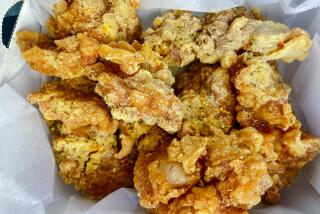Posing Challenge to Beef : Rise in Eating of Chicken Something to Crow About
BOAZ, Ala. — Mike Harris is a chicken catcher.
His days are spent wading into fussing, flapping flocks of thousands of plump white birds. He grabs them by the feet, gathering up 10 to 12 broilers at a time. In an average work day, Harris, 37, and eight men who work with him will catch more than 50,000 chickens.
It is a dirty job. Harris is always covered with dust and feathers glued to his body and clothes by sweat and Alabama’s humid air. And these days, he is busier than ever.
Americans have never before gobbled up so much chicken. This year they will eat almost as much chicken as pork. If projections hold, in only a few more years chicken may be challenging beef as the meat of choice.
“Right now, chicken is fashionable, it’s hot,” says Paul Aho, a University of Georgia poultry economist.
“Our time has arrived,” says Harold O. Chitwood, who oversees poultry operations for Gold Kist Inc., a major chicken packer.
Once a Delicacy
Dramatic changes in life styles and eating habits are responsible for the trend. Just 50 years ago, when Herbert Hoover promised “a chicken in every pot,” Americans were eating only about half a pound of chicken each a year. This year, they will consume 60 pounds a person.
On the average, as much chicken is sent to market in the United States every 36 hours as the entire nation consumed in all of 1935.
Demand peaks over the Fourth of July holiday, when chicken sales soar 16% above average and prices reach the high point of the year. The bird has become as much a part of the Independence Day tradition as hot dogs and fireworks.
Once coveted by the poor, and reserved for special meals even by those who could afford it, chicken today is just another fast food. Kentucky Fried Chicken alone now sells 355 million birds a year--15% more than in 1980. Industry sources estimate that chicken now accounts for about 10% of McDonald’s sales.
The chicken business began as a barnyard enterprise, with hundreds of thousands of small farmers producing an uneven supply of birds. Now chickens are called broilers, and the business has become one of America’s most highly organized, sophisticated and successful agricultural enterprises.
“I don’t know of anything in farming that’s close to it,” says Dan Smalley, who raises 2.5 million chickens each year on his Arab, Ala., farm. “We’ve remained profitable even in bad times.”
The broiler industry has producers and packers crowing. In 1985, it produced just under 4.8 billion birds. Consumers spent $15 billion for retail chicken, both at grocery stores and restaurants. (Poultry, including eggs and turkeys, is California’s third largest agricultural commodity, with combined cash receipts close to the $900-million mark annually.)
Reasons for Popularity
Rising chicken consumption mirrors a changing America. Among the reasons demand is increasing:
--Dietary and health concerns. The poultry industry, doctors and nutritionists all say that chicken is lower in fat and easier to digest than other meats, yet contains the same amount of protein. The red meat industry contends that there is very little difference in the fat, calorie and cholesterol contents of pork, beef and poultry.
--Changing life styles. “We used to sit down to a Sunday roast that took three hours to prepare, and people aren’t doing that any more,” says Craig Mitchell of the National Livestock and Meat Board. “People don’t want to buy something that is going to feed a family of four for three meals.”
--Smaller families and an increasing number of single persons living alone. Chicken today is a convenience food, available in pieces or in preprocessed forms that can take only a few minutes to prepare. “We’re trying to move into smaller portions, something that can take a half-hour to prepare and feed one or two persons. Poultry is way ahead of us in this,” says Mitchell.
Less Expensive Protein
--Price. “Poultry is a less expensive source of protein,” says Edward Naber, Ohio State University poultry scientist. Chicken costs less today, after adjustments for inflation, than it did 20 years ago, according to agricultural economists.
--The fast food industry. This is perhaps the most dramatic single factor in the increased chicken consumption. For example, the market for chicken nuggets alone--a product created only three years ago--will top a billion pounds this year, or 10 times the entire nation’s chicken consumption in 1935.
Chicken prices are up significantly this month, as the nation’s three largest hamburger chains stock up for summer promotions. “The nugget pushed down the accelerator for us and has given us a lot more momentum,” says Bill Roenigk, National Broiler Council economic research director. “It’s no big secret--we’re working on a beef nugget,” says Mitchell.
--The substitution of chicken for other meats in, for example, chicken hot dogs, chicken burgers and chicken sausages. They currently do not account for a large percentage of poultry sales, but they offer alternatives.
‘Mother Hen’ of Broilers
Although she is not one of the 57 persons in the American Poultry Hall of Fame (Oh yes, there is one--in Beltsville, Md.), Cecile Steele of Ocean View, Del., is considered the mother hen of the broiler industry.
Steele started the chicken revolution when she began raising flocks only for their meat. She did this in 1923, about 6,000 years after the chicken, a native of Southeast Asian jungles, was domesticated.
Before Steele came along, the nation’s chicken supply was chiefly has-been hens who went to the butcher when their egg production dropped below the cost of chicken feed. Steele’s contribution has not gone entirely unrecognized. The people of Delaware have put her chicken coop in a state museum.
Today, the broiler is big business. More than 50% of the market is controlled by eight companies that manage production in assemby-line fashion. Virtually all poultry production is confined to the Southeastern states and California.
Most Mechanized Processing
“It is an industry that is the leader in mechanization and automation among all the animal-processing industries,” says John L. Skinner, a poultry historian. It is also a business that has made good use of the agricultural laboratory and of advances in breeding.
For example, in 1940, it took 16 weeks to produce a three-pound broiler. Today, it takes seven weeks to raise a 4.2-pound bird. In 1940, a chicken ate three pounds of feed for every pound it gained. Today, it eats two pounds or less for every pound it gains. (By comparison, cattle eat eight pounds of feed to gain one pound of body weight; hogs eat four pounds for every pound gained.)
The broiler industry is the most structured business in agriculture. From the hatching to the hatchet, every level of production is controlled.
Farmers work under contract, either caring for breeder flocks and collecting eggs or raising broilers. In either case, the farmer supplies the labor and the facilities and the poultry processor provides the birds, specially formulated feed from their own mills and experts who inspect the flocks regularly.
Conveyor-Belt Existence
A measure of the size and complexity of the business can be seen at the Gold Kist facility in the misty foothills of the Great Smoky Mountains in northeast Alabama, where four hatcheries produce 1.65 million chicks a week.
“It takes a lot of chicks to feed this country,” says Bill Bailey, manager of breeder operations. The business at Gold Kist is so well regulated now that chicks are hatched only on Mondays, Tuesdays, Thursdays and Fridays--after the eggs spend 21 days and two hours in the incubators, where they are mechanically turned every hour.
The chicken’s seven weeks of life begins--and ends--on a conveyor belt.
Minutes after they hatch, the chicks are moving along on a conveyor to be vaccinated, counted and placed in plastic trays, 100 birds to a tray. Hours later, they are on a farm in one of the half-block-long chicken houses where they will spend the rest of their short lives. The buildings seem almost empty as 20,000 of the tiny, fluffy yellow chicks begin feeding on the scientifically designed diet.
Seven weeks later, the dirt floors of the long chicken houses resemble white carpets of feathers as Mike Harris and his chicken-catching crew move in.
Automation Contains Costs
At the processing plant, the birds are placed on a conveyor belt for a ride along the disassembly line--a whirling, steaming, slicing, stainless-steel mechanized wonder capable of dressing 96,000 birds in a shift.
“It doesn’t cost us any more to dress (prepare a bird for market) today than it did 15 years ago,” says Dean Strickland, a Gold Kist field operations manager. “We just keep automating.”
The bird is ready for market 70 minutes later. Nothing has been wasted in the process. What cannot be eaten by humans is processed into animal feed.
“We use everything,” says Gold Kist poultry chief Harold Chitwood.
“Everything but the cackle.”
More to Read
Eat your way across L.A.
Get our weekly Tasting Notes newsletter for reviews, news and more.
You may occasionally receive promotional content from the Los Angeles Times.










